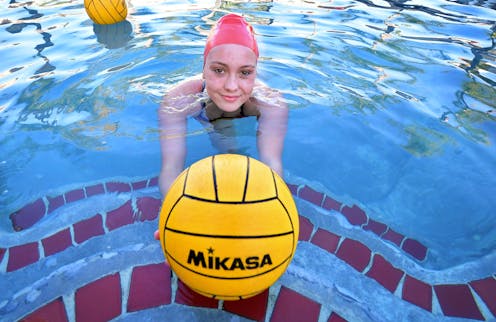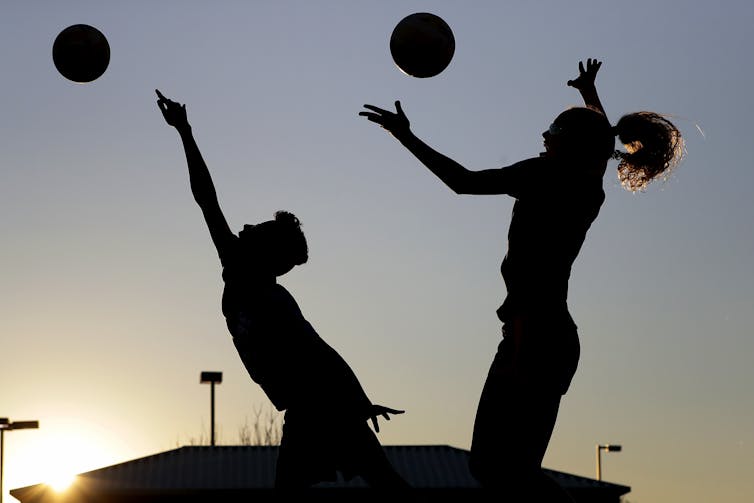Why student athletes need a new playbook to stay safe in the COVID-19 era
Kids want to play sports again, and who can blame them? An exercise scientist and physiologist explains why adhering to safety protocols is imperative.

Kids are eager to play ball, and parents are eager to be back on the sidelines supporting them. But COVID-19 cases have risen in places where kids have been playing sports, complicating the issue.
Michigan, where I live, is now the epicenter of COVID-19 cases in the U.S. The resumption of youth sports activities has been widely implicated in Michigan’s latest COVID-19 surge, with 40% of new outbreaks occurring in K-12 schools or youth programs.
Experts also blame Michigan’s unprecedented rise to the top on an unfortunate mixture of reopening, virus variants and COVID-19 fatigue.
As an exercise scientist and clinician, I believe that sports participation – and even watching sports – has health and social benefits which far exceed winning and losing. My physiologist brain, however, argues that at this very moment, people should be focusing their energy not against each other, but rather toward defeating the world’s deadliest team: SARS-CoV-2, or, if you will, Team Coronavirus.

Humans as the underdog
Parents in Michigan have started a group called Let Them Play Michigan to press the issue. Specifically, the group opposes mandatory weekly testing of student athletes, which the state requires, and quarantining of young athletes who test positive.
Recently, Let Them Play Michigan filed a lawsuit against the state of Michigan to ease mandatory testing restrictions in high school athletes, arguing that the state health department does not have the authority to issue these restrictions.
I still consider myself an athlete, even though jogging three miles a day is a low performance bar. That’s why at an emotional level, the Let Them Play youth sports movement touches my heart, since athletes resent anything that keeps them off the field, court or pitch.
So I suggest public health experts, parents and other stakeholders consider the issue through the lens of sports – Team People against Team Coronavirus. Team Coronavirus is focused solely on winning (survival) and will seize upon any mammal with properly fitting ACE2 (angiotensin converting enzyme 2), liver heparin or other receptors high in sialic acid. Once Team Coronavirus invades a cell’s nucleus, the virus delivers instructions to replicate, particularly within lung and upper airway cells.
Once a person is infected, millions of coronavirus particles can spew out of an infected host’s nose and mouth with every breath, cough, sneeze or word spoken. It can even exit through the rectum. The SARS-CoV-2 virus can also enter our bodies through the mucous membranes of our eyes, as fast as cutting an onion can make us cry.
A particularly daunting skill set of Team Coronavirus is its ability to change shape and evade the Team People’s defense, or immune, system. So think of it like a new team taking the court after half-time. Not only have the players never seen this team, but the coaches haven’t seen the films.
The possibility that Team Coronavirus can hide undetected within tissue reservoirs, such as in the brain, nervous system, eyes, heart or lungs, is another under-recognized skill of SARS-CoV-2. Scientists hypothesize that this ability may contribute to its persistence in both acute and chronic disease states, such as long haulers’ COVID-19.
Given our current understanding of Team Coronavirus’ expanding playbook, is it possible to safely let kids play sports during a pandemic, without some restrictions?
The NBA did it, but at a high cost
The success of the NBA Bubble demonstrates that competitive sports can be performed safely – and without vaccines – by adhering to strict safety protocols. That includes rigorous – meaning daily – testing, isolation and quarantine measures.
The financial cost of allowing 22 NBA teams to compete over about 100 days was about US$190 million, with additional, intangible mental health and emotional costs experienced by players and coaches.
However, the bubble clearly showed that Team Coronavirus can be defeated, but with significant personal and financial sacrifice.
The irony of the youth sports movement, as detailed in the current Let Them Play Michigan lawsuit, is the unsportsmanlike intention to cut corners on the evidenced-based safety measures in order for the kids to play. Adults filing the lawsuit on kids’ behalf are suggesting that weekly testing is too much, or that quarantining if an infection is found is too onerous. This parental response may be because kids are complaining.
Adults cannot let kids make these decisions. Despite the best of intentions, adolescents are poor judges of health risks. Sure, they may not want to accept weekly COVID-19 testing, but adults need to make sure they follow the rules. The NBA’s experience shows that testing should be an essential part of the rules.
One of Team Coronavirus’ most devastating offensive plays is its invisibility, or asymptomatic spread. Regular COVID-10 testing, as a major defensive strategy, identifies genetic material from Team Coronavirus so that any infected players can promptly be removed from play, limiting the spread of COVID-19 by removing their best players – superspreaders with high viral loads. This is why quarantining is so important.
Another highly effective defensive strategy against Team Coronavirus is covering both mouths and noses with masks to limit the airborne transfer of viral particles between players. The argument that masks are ineffective is true when face masks are not worn correctly (as widely seen around the chin).
If regular testing and wearing masks during games could save the life of a beloved football player, fellow basketball-playing exercise science student or collegiate March Madness superfan, how can parents and coaches not consider such minor inconveniences to save a coach’s, parent’s or teammate’s life?
Every COVID-19 death is preventable. Every loss, unconscionable.
Going into overtime
One scary consequence of COVID-19 is the potential for long-lasting disability in those infected with SARS-CoV-2. While people itching for normalcy may think of an attack by Team Coronavirus as a “one-and-done” affair, post-infective fatigue, mental debility, neuralgia and psychoses are just getting started in patients with long-haul cases.
A growing body of evidence suggests that recovery from asymptomatic or mildly symptomatic COVID-19 may be associated with residual inflammation around the heart, impairment of blood flow, multi-organ impairment (brain, lungs, kidney, liver, pancreas and spleen), sustained fatigue and exercise intolerance.
This post-COVID-19 syndrome is recognized as “long-haulers” syndrome worldwide and causes neurologic dysfunction and debilitating fatigue in both young adults and children.
The SARS epidemic from 2003 provides a cautionary tale. In fact, 40.3% of patients who were diagnosed with SARS-CoV-1 faced chronic fatigue, and 42.5% experienced psychiatric illness up to four years later.
Let them play, but with firm rules in place
The question for parents, public health officials and school officials is: How do we let kids play and keep them safe? I believe there are ways to do this.
Get tested regularly.
Wear masks properly – block virus transmission by covering both the mouth and nose.
Embrace shared sacrifice.
Support one another – sustained sacrifice is hard, so work together and check in regularly with teammates.
Play outside – or have adequate ventilation inside to disperse viral particles.
As current underdogs, athletes, coaches, parents and fans need to dig deep, embrace discomfort and beat this virus once and for all.
[Get facts about coronavirus and the latest research. Sign up for The Conversation’s newsletter.]
Tamara Hew-Butler does not work for, consult, own shares in or receive funding from any company or organisation that would benefit from this article, and has disclosed no relevant affiliations beyond their academic appointment.
Read These Next
Epstein’s victims deserve more attention than his ‘client list’
Powerful men connected to Jeffrey Epstein are named, dissected and speculated about. The survivors,…
The ‘one chatbot per child’ model for AI in classrooms conflicts with what research shows: Learning
AI tutors are often held up as an ideal, but prioritizing individualized teaching can detract from the…
How the NIH became the backbone of American medical research and a major driver of innovation and ec
The agency’s budget has grown steadily since the 1960s, fueling an industry that creates lifesaving…





